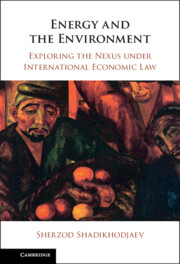Book contents
- Energy and the Environment
- Energy and the Environment
- Copyright page
- Dedication
- Contents
- Figures
- Tables
- Table of Cases
- Table of Treaties
- Table of Other Legal Texts (and Drafts)
- Abbreviations
- Introduction
- 1 Foundations of the Energy–Environment Nexus and International Economic Law
- 2 Energy Trade Control and Environmental Protection
- 3 Energy Subsidies and the Environment
- 4 Pro-environmental Energy Standards and Trade
- 5 Energy Investment Regulation and the Environment
- 6 Energy and Green Technologies
- Conclusion
- Book part
- Bibliography
- Index
1 - Foundations of the Energy–Environment Nexus and International Economic Law
Published online by Cambridge University Press: 30 April 2024
- Energy and the Environment
- Energy and the Environment
- Copyright page
- Dedication
- Contents
- Figures
- Tables
- Table of Cases
- Table of Treaties
- Table of Other Legal Texts (and Drafts)
- Abbreviations
- Introduction
- 1 Foundations of the Energy–Environment Nexus and International Economic Law
- 2 Energy Trade Control and Environmental Protection
- 3 Energy Subsidies and the Environment
- 4 Pro-environmental Energy Standards and Trade
- 5 Energy Investment Regulation and the Environment
- 6 Energy and Green Technologies
- Conclusion
- Book part
- Bibliography
- Index
Summary
The intersection between energy and the environment is regulated on the basis of legal foundations that international economic law has developed on its own or ‘borrowed’ from (or otherwise relied on) such outside regimes as general international law and international environmental law. The borrowed principles, like sovereignty over natural resources or sustainable development, can find their reflection, directly or indirectly, in trade and investment agreements and case law and will continuously affect new developments in this field. This chapter will show that such foundations stemming from the external sources define the basic contours of State’s rights and duties associated with the energy–environment nexus. Moreover, the international trading and investment systems provide self-created legal foundations for environmental policy space as will also be discussed in this chapter. They define the extent to which energy-related restrictive measures driven by environmental considerations can be accepted. The case of the ECT presented at the end of this chapter is a striking example for demonstrating that the legal foundations are not static and may undergo important changes.
Keywords
- Type
- Chapter
- Information
- Energy and the EnvironmentExploring the Nexus under International Economic Law, pp. 12 - 56Publisher: Cambridge University PressPrint publication year: 2024

